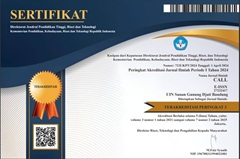CONVERSATIONAL IMPLICATURE: TALKSHOW IN OPRAH WINFREY NETWORK
DOI:
https://doi.org/10.15575/call.v3i2.15025Abstract
This study is to determine the various forms of conversational implicature and their function on the talk show Oprah Winfrey Network's SuperSoul Sunday Program. The data were evaluated descriptively qualitatively. The results show that three types of data classified as generalized conversational implicature and eleven types of data classified as particularized conversational implicature, depending on the utterance. Each host has a unique personality and circumstance, which contributes to defiance of the dictum. By floating the maxim, the speaker inferred meaning through his or her justifications, which either too brief or too detailed. As a result, the speaker delivered an irrelevant and ambiguous speech in response to the interlocutor. In conclusion, this implicature discovered the representational, directive, expressive, and declarative functions of utterances.
Keywords: Implicature, Conversational Implicature, Talkshow, Floating The Maxim
References
Akmal, S., & Yana, D. U. (2020). Conversational Implicature Analysis in “Kingdom of Heaven†Movie Script by William Monahan. Buletin Al-Turas, 26(2), 335–350. https://doi.org/10.15408/BAT.V26I2.15356
Chapman, S. (2005). Logic and Conversation. Paul Grice, 85–113. https://doi.org/10.1057/9780230005853_5
Creswell, J. W. (2014). Research Design Qualitative, Quantitative, and Mixed Method Approaches. SAGE Publication, Inc. https://doi.org/https://b-ok.asia/book/3700358/d95149
Grice, H. P. (2012). Further Notes on Logic and Conversation. Reasoning, 765–773. https://doi.org/10.1017/CBO9780511814273.039
Gu, C., & Tipton, R. (2020). (Re-)voicing Beijing’s discourse through self-referentiality: a corpus-based CDA analysis of government interpreters’ discursive mediation at China’s political press conferences (1998–2017). Perspectives: Studies in Translation Theory and Practice, 28(3), 406–423. https://doi.org/10.1080/0907676X.2020.1717558
Haugh, M. (2007). The co-constitution of politeness implicature in conversation. Journal of Pragmatics, 39(1), 84–110. https://doi.org/10.1016/J.PRAGMA.2006.07.004
Khairunas, S., Sidauruk, J., Desi Pratama, R. M., & Dwi Natalia, T. O. M. (2020). Conversational Implicature in Beauty and Beast Movie Directed by Bill Condon. Wanastra: Jurnal Bahasa Dan Sastra, 12(1), 16–24. https://doi.org/10.31294/W.V12I1.7459
Levinson, M. (2010). From Fear to Facebook One School’s Journey. International Society for Technology in Education.
Ma, W., & Zhang, S. (2020). Research Methods in Linguistics. Australian Journal of Linguistics, 40(2), 269–270. https://doi.org/10.1080/07268602.2019.1574777
Meyer, J. (2018). What is Literature? A Definition Based on Prototypes. Work Papers of the Summer Institute of Linguistics, University of North Dakota Session, 41(1). https://doi.org/10.31356/silwp.vol41.03
Op.Sunggu, E. J., & Afriana, A. (2020). Flouting Maxims in “Wonder Woman“ Movie. Linguistic, English Education and Art (LEEA) Journal, 4(1), 1–12. https://doi.org/10.31539/LEEA.V4I1.1394
Over, D. E., & Grice, P. (1990). Studies in the Way of Words. The Philosophical Quarterly, 40(160), 393. https://doi.org/10.2307/2219730
Stevenson, M. B., Ver Hoeve, J. N., Roach, M. A., & Leavitt, L. A. (1986). The beginning of conversation: Early patterns of mother-infant vocal responsiveness. Infant Behavior and Development, 9(4), 423–440. https://doi.org/10.1016/0163-6383(86)90016-0
Sutherland, S. (2016). A Beginner’s Guide to Discourse Analysis. A Beginner’s Guide to Discourse Analysis. https://doi.org/10.1007/978-1-137-40289-9
Taguchi, N. (2008). Cognition, language contact, and the development of pragmatic comprehension in a study-abroad context. Language Learning, 58(1), 33–71. https://doi.org/10.1111/J.1467-9922.2007.00434.X
van Tiel, B., & Schaeken, W. (2017). Processing Conversational Implicatures: Alternatives and Counterfactual Reasoning. Cognitive Science, 41, 1119–1154. https://doi.org/10.1111/COGS.12362
Yule, G. (1989). The study of language. In Semantics (pp. 114–127).
Downloads
Published
Issue
Section
Citation Check
License
Authors who publish in CALL agree to the following terms:
- Authors retain copyright and grant the journal right of first publication with the work simultaneously licensed under Attribution-ShareAlike 4.0 International (CC BY-SA 4.0) License that allows others to share the work with an acknowledgment of the work's authorship and initial publication in this journal.
- Authors are able to enter into separate, additional contractual arrangements for the non-exclusive distribution of the journal's published version of the work (e.g., post it to an institutional repository or publish it in a book), with an acknowledgment of its initial publication in this journal.
- Authors are permitted and encouraged to post their work online (e.g., in institutional repositories or on their website) prior to and during the submission process, as it can lead to productive exchanges, as well as earlier and greater citation of published work (See The Effect of Open Access).




